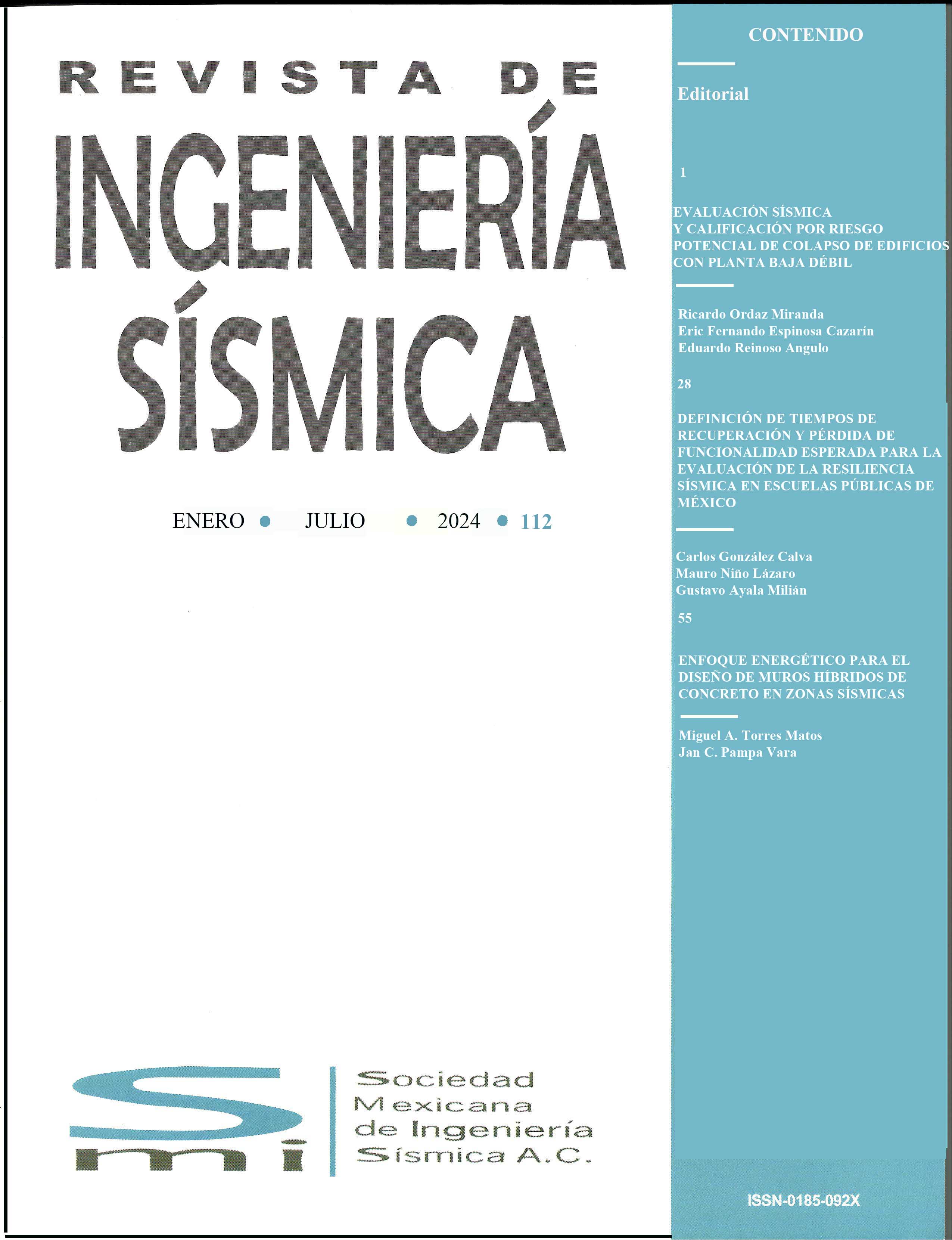CAMBIOS EN LAS PROPIEDADES DINÁMICAS DE UN EDIFICIO EXPERIMENTAL MEDIANTE EL ANÁLISIS DE VIBRACIÓN AMBIENTAL Y VIBRACIÓN FORZADA
DOI:
https://doi.org/10.18867/ris.108.598Palabras clave:
edificio experimental, laboratorio Charles Lee Powell, formas modalesResumen
En este trabajo se analizan registros de vibración ambiental y de vibración forzada para determinar las propiedades dinámicas (formas modales y frecuencias características) de un edificio experimental de cinco pisos que fue construido a escala real dentro del laboratorio Charles Lee Powell de la Universidad de California en San Diego (UCSD). Este fue el primer edificio a escala real, construido en el año 1992, para realizar pruebas de resistencia sísmica en los Estados Unidos de América. Los registros de vibración se obtuvieron durante las tres etapas de las condiciones físicas del edificio: edificio recién construido, edificio dañado con carga sísmica simulada y edificio reparado. En los resultados del análisis, tanto de vibración ambiental como forzada, se observan cambios en sus propiedades dinámicas debido a la degradación de la rigidez en el edificio con daño y a la recuperación de la rigidez en el edificio reparado.
Descargas
Citas
Bendat, J.S., y Piersol, A.G. (1971), Random Data: Analysis and Measurement Procedures, 2nd edn, John Wiley and Sons Inc, New York. 407 p. ISBN 10: 047106470X.
Casas-Guzik, N. (2019), “Ensaye de un edificio de mampostería confinada de 5 niveles a escala en mesa vibradora”, Tesis de Maestría, Universidad Nacional Autónoma de México, 257 p.
Chakra-Varthy, P., y Basu, D. (2021). “Natural period and vertical distribution of base shear in confined masonry buildings using ambient vibration test”, Bulletin of Earthquake Engineering, 19(4), 1851-1899. DOI: 0.1007/s10518-021-01046-8.
De-la-Colina, J., y Valdés-González, J. (2021). “Forced-vibration tests of a reinforced concrete four-story building structure”, Journal of Structural Engineering, 147(7), 04721004. DOI: 10.1061/(ASCE)ST.1943-541X.0003011
FEMA Federal Emergency Management Agency, (1988a), “NEHRP Recommended provisions for the development of seismic regulations for new buildings. Part I: Provisions”. Earthquake Hazards Reduction Series 17. Washington, D.C. FEMA 95.
FEMA Federal Emergency Management Agency, (1988b), “NEHRP Recommended provisions for the development of seismic regulations for new buildings. Part II: Commentary”. Earthquake Hazards Reduction Series 18. Washington, D.C. FEMA 96.
Henao Ángel, D., Botero Palacio, J. C., y Muriá Vila, D. (2014). “Identificación de propiedades dinámicas de un modelo estructural sometido a vibración ambiental y vibración forzada empleando mesa vibradora”, Ingeniería sísmica, (91), 54-73. DOI: 10.18867/RIS.91.181.
Inci, P., Goksu, C., Tore, E., y Ilki, A. (2021). “Effects of seismic damage and retrofitting on a full-scale substandard RC building-ambient vibration tests”, Journal of Earthquake Engineering, 1-28. DOI: 10.1080/13632469.2021.1887009.
International Conference of Building Officials (1991), “Uniform Building Code”. International Conference of Building Officials. Whittier, California, U.S.A. 1050 p. ISSN: 0896-9655.
Khanmohammadi, M., Eshraghi, M., Behboodi, S., Mobarake, A. A., y Nafisifard, M. (2021). Dynamic characteristics and target displacement of damaged and retrofitted residential buildings using ambient vibration tests following Sarpol-e Zahab (Iran) Earthquake (Mw 7.3)”, Journal of Earthquake Engineering, pp. 1-28. DOI: 10.1080/13632469.2021.1911880
Motamedi, M., Ventura, C. E., Lara, O., y Barredo, J. H. (2021). “Ambient vibration tests and modal response analysis of Guayaquil metropolitan cathedral in Guayaquil, Ecuador”, en: Pakzad S. (eds) Dynamics of Civil Structures, Volume 2. Conference Proceedings of the Society for Experimental Mechanics Series. pp. 75-89. Springer, Cham. DOI: 10.1007/978-3-030-47634-2_9.
Pepi, C., Cavalagli, N., Gusella, V., y Gioffrè, M. (2021). “Damage detection via modal analysis of masonry structures using shaking table tests”, Earthquake Engineering & Structural Dynamics, 50(8), 2077-2097. DOI: 10.1002/eqe.3431.
Seible F., Hegemier G.A., Priestley M.J.N., Kingsley G., Kürkchübasche A., Igarashi A., y Weeks J. (1994), “The U.S.-TCCMAR Full-scale five-story masonry research building test. Part I – Executive Summary. Report No. SSRP-94/01”. Department of Applied Mechanics and Engineering Sciences, University of California, San Diego. 71 pp.
Souici, R., Ait-Meziane, Y., y Benouar, D. (2021). “Identification of vibration direction of existing buildings using ambient vibration noise tests”, Arabian Journal of Geosciences, 14(1), 1-12. DOI: 10.1007/s12517-020-06306-6.
Weeks J., Seible F., Hegemier G., y Priestley M.J.N. (1994). “The U.S.-TCCMAR Full-scale five-story masonry research building test. Part V – Repair and Retest. Report No. SSRP-94/05”. Department of Applied Mechanics and Engineering Sciences, University of California, San Diego. 115 pp.







